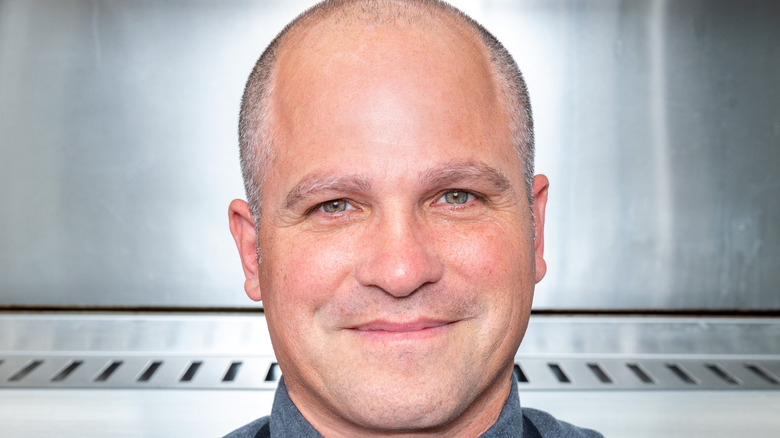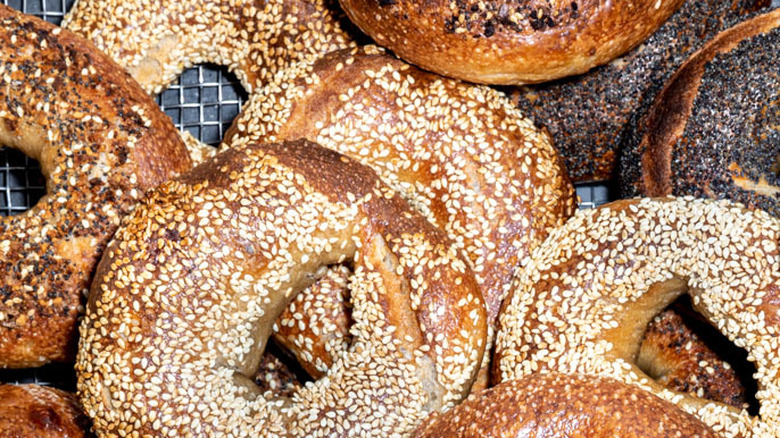Brad Kent Explains How To Tell If You're Eating A Traditional Bagel - Exclusive
Brad Kent is the co-founder of Blaze Pizza, and as its Head Food Guy, he knows a thing or two about what makes a fantastic slice. But, Kent is also on the verge of opening a new restaurant, Bagel + Slice, in Los Angeles, which will be serving up New York City-style bagels as well as pizza. In an exclusive interview with Mashed, Kent revealed that the majority of bagels you're eating are pale copycats of an authentic staple.
In fact, Kent spent 11 years researching, developing, and experimenting before finding the right recipe. We at Mashed were fortunate to have the opportunity to sample Kent's bagels, and he has definitely succeeded, developing a crispy crust and a slightly sweet bread with a nice chew. He's also done the impossible by creating a gluten-free bagel that virtually has the taste and texture of the traditional kind. It's made from sunflower seed flour, buckwheat flour, and wheat starch and, according to Kent, is easily digested by people with celiac disease or those with gluten sensitivities.
The aroma of Kent's bagels (and stunningly yummy bialys) is also alluring because of the special wheat flour he uses in his dough. He has 11 suppliers of organic or regenerative organic wheat, and the type he uses changes depending on what's available from the mostly local farms he works with — in total, he purchases 2,000 pounds of wheat flour every week since it also goes into his famous pizza dough. When it comes to a real bagel, Kent told Mashed, "[It] shouldn't be made with bleached flour or from a mix. It should be made with flour that was grown by farmers that [care] about the planet and care about making flour that tastes like wheat." But that's not the only tell-tale sign of a non-authentic variety.
You can spot a fake bagel by the seeds, says Brad Kent
To demonstrate what makes a "real" bagel, Brad Kent exclusively walked Mashed through the step-by-step process for baking one that — if you're a native New Yorker — you, your parents, and grandparents all loved. As Kent explained it, "You mix dough, you ferment it, you shape it into rings, [and] it gets fermented overnight in a refrigerator." Very few bagel bakeries in Los Angeles hand-roll the bagels anymore and instead use machines, which are less labor-intensive, but Kent insisted that a "perfectly imperfect" bagel heightens the overall experience of eating a true New York-style variety.
Once the bagels are formed, they're then boiled in water sweetened with malt syrup and placed upside down onto a wet burlap-wrapped board. The wet boards are key, as they prevent the sticky bagels from sticking to the bottom of the oven.
"So you have to wait for the bottoms to dry before you flip them off the boards and bake them, now with the top side facing up with the dry bottoms until they're finished baking," he explains.
According to Kent, a number of bagel places in LA don't do it this way. "The untraditional way is you'll see seeds on the top and bottom," he says.
He explained that most people like seeds on both sides for an open-faced bagel sandwich. "So I'm not saying that that always is the telltale sign, but it's a really good indication that something might be fishy," Kent says. "So look around at those places that are seeding tops and bottoms, they probably are baking on parchment-lined sheet pans, not using bagel boards, not adhering to the traditional standards. And that's really important to me because I need to keep [the] Jewish bagel-making tradition alive."
Look out for the opening of Bagel + Slice by following the restaurant on Instagram.

